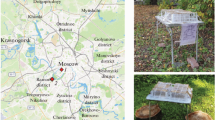Abstract
The oak processionary moth (Thaumetopoea processionea L.) is found in oak forests in most European countries. The caterpillars bear urticating hairs (setae) as a chemical defence. These hairs break off and are small enough to become airborne and be transported by the wind. Upon contact with humans the toxin can cause an allergic reaction that ranges from a skin rash to respiratory distress. In order to measure the terminal settling velocity of this bioaerosol, we used a small elutriator and tested its functionality with particles of known aerodynamic diameter. We determined that the mean settling velocity of the setae is about 1 cm/s, corresponding to an aerodynamic diameter of 19 μm for setae with a diameter of 6 μm and a length of 190 μm. The dispersion of the hairs in the atmosphere for a typical summer day was calculated by means of an Eulerian model. The results of this calculation revealed that the maximum concentrations in the atmosphere on a typical summer day reach 20–30% of the concentration found directly at the source. Those maximum concentrations are reached at a distance from the source that varies between 174 and 562 m, depending on the atmospheric stability and the settling velocity.






Similar content being viewed by others
Notes
The name ‘processionary moth’ derives from a unique behaviour of the caterpillars, i.e. their moving in large processions, head to tail. This behaviour is most noticeable when the larvae crawl to the crowns of the oak trees to feed on leaves.
References
Adrian, G., & Fiedler, F. (1991). Simulation of unstationary wind and temperature fields over complex terrain and comparison with observations. Contributions to Atmospheric Physics, 64, 27–48.
Baron, P. A. (1993). Measurement of asbestos and other fibers, aerosol measurement: Principles, techniques, and applications (pp. 560–590) New York: Van Nostrand Reinhold.
Cox, R. G. (1970). The motion of long slender bodies in a viscous fluid 1: General theory. Journal of Fluid Mechanics, 44, 791–810.
Ducombs, G., Lamy, M., Bergaud, J.-J., Tamisier, J.-M., Gervais, C., & Texier, L. (1979). La chenille processionnaire (Thaumetopoea pityocampa Schiff. Lépidoptéres) et l’homme: Étude morphologique de l’appareil urticant. Enquête épidémiologique. Annales de Dermatologie et de Vénéréologie, 106, 769–778.
Gäbler, H. (1954). Die Prozessionsspinner. (Wittenberg Lutherstadt: A. Ziemsen Verlag), 3–7, 29–37.
Goldsmith, L., & Baden, H. (1970). The mechanical properties of hair. I. The dynamic sonic modulus. Journal of Investigative Dermatology, 55, 256–259.
Hammer, M.-U., Vogel, B., & Vogel, H. (2002). Findings on H 2 O 2/HNO 3 as an indicator for ozone sensitivity in Baden-Württemberg. Berlin-Brandenburg and the Po valley based on numerical simulations. Journal of Geophysical Research, 107, 8190. doi:10.1029/2000JD000211.
Helbig, N., Vogel, B., Vogel, H., & F. Fiedler, F. (2004). Numerical modelling of pollen dispersion on the regional scale. Aerobiologia, 20, 3–19.
Hesler, L. S., Logan, T. M., Benenson, M. W., & Moser, C. (1999). Acute dermatitis from oak processionary caterpillars in a U.S. military community in Germany. Military Medicine, 164, 767–770.
Lamy, M., Novak, F., Duboscq, M. F., Ducombs, G., & Maleville, J. (1988). La chenille processionnaire du chêne (Thaumetopoea processionea L.) et l’homme: Appareil urticant et mode d’action. Annales de Dermatologie Et De Vénéréologie, 115, 1023–1032.
Lenz, C.-J. (1996). Energieumsetzungen an der Erdoberfläche in gegliedertem Gelände. Germany: Wissenschaftliche Berichte des Instituts für Meteorologie und Klimaforschung der Universität Karlsruhe (TH).
Maier, H., Spiegel, W., Kinaciyan, T., Krehan, H., Cabaj, A., Schopf, A., & Hönigsmann, H. (2003). Contact Dermatitis and Allergy: The oak processionary caterpillar as the cause of an epidemic airborne disease: Survey and analysis. British Journal of Dermatology, 149, 990–997.
Maksymov, J. K. (1978). Thaumetopoeidae, Prozessionspinner. In W. Schwenke (Ed.), Die Forstschädlinge Europas. (pp. 391–404). Hamburg and Berlin: Verlag Paul Parey).
Nester, K., Panitz, H.-J., & Fiedler, F. (1995). Comparison of the DRAIS and EURAD model simulations of air pollution in a mesoscale area. Meteorology and Atmospheric Physics, 57, 135–158.
Riemer, N., Vogel, H., Vogel, B., & Fiedler, F. (2003). Modelling aerosols on the mesoscale-g: Treatment of soot aerosol and its radiative effects. Journal of Geophysics Research, 109, 4601. doi:10.1029/2003JD003448.
Schädler, G. (1989). Numerische Simulationen zur Wechselwirkung zwischen Landoberflächen und atmosphärischer Grenzschicht. Germany: Wissenschaftliche Berichte des Instituts für Meteorologie und Klimaforschung der Universität Karlsruhe (TH).
Spiegel, W., Maier, H., & Maier, M. (2004). A non-infectious airborne disease. Lancet, 363, 1438.
Scheidter, F. (1934). Forstentomologische Beiträge. Zeitschrift für Pflanzenkrankheiten und Pflanzenschutz, 44, 223–226, 362–379, 385–423, 497–525.
Tangermann-Dlugi, G., & Fiedler, F. (1983). Numerische Simulation turbulenter Ausbreitungsvorgänge in der atmosphärischen Grenzschicht. Wasserwirtschaft, 73, 411–415.
Vogel, B., Fiedler, F., & Vogel, H. (1995). Influence of topography and biogenic volatile organic compounds emission in the state of Baden-Württemberg on ozone concentrations during episodes of high air temperatures. Journal of Geophysical Research, 100, 22907–22928.
Vogel, B., Riemer, N., Vogel, H. & Fiedler, F. (1999). Findings on NOy as an indicator for ozone sensitivity based on different numerical simulations. Journal of Geophysical Research, 3605–3620.
Weidner, H. (1937). Beiträge zu einer Monographie der Raupen mit Gifthaaren. Zeitschrift für angewandte Entomologie, 23, 432–484.
Werno, J., & Lamy, M. (1990). Pollution atmosphèrique d’origine animal: les poils urticants de la chenille processionnaire du pin (Thaumetopoea pityocampa Schiff.). Comptes Rendus de l’Académie des Sciences, Paris, Série III, 310, 325–331.
Werno, J., Lamy, M, & Vincendeau P. (1993). Caterpillar hairs as allergens. Lancet, 342, 936–937
Author information
Authors and Affiliations
Corresponding author
Rights and permissions
About this article
Cite this article
Fenk, L., Vogel, B. & Horvath, H. Dispersion of the bio-aerosol produced by the oak processionary moth. Aerobiologia 23, 79–87 (2007). https://doi.org/10.1007/s10453-007-9053-3
Received:
Accepted:
Published:
Issue Date:
DOI: https://doi.org/10.1007/s10453-007-9053-3




